Tanmay Rajpurohit
Agent Context Protocols Enhance Collective Inference
May 20, 2025Abstract:AI agents have become increasingly adept at complex tasks such as coding, reasoning, and multimodal understanding. However, building generalist systems requires moving beyond individual agents to collective inference -- a paradigm where multi-agent systems with diverse, task-specialized agents complement one another through structured communication and collaboration. Today, coordination is usually handled with imprecise, ad-hoc natural language, which limits complex interaction and hinders interoperability with domain-specific agents. We introduce Agent context protocols (ACPs): a domain- and agent-agnostic family of structured protocols for agent-agent communication, coordination, and error handling. ACPs combine (i) persistent execution blueprints -- explicit dependency graphs that store intermediate agent outputs -- with (ii) standardized message schemas, enabling robust and fault-tolerant multi-agent collective inference. ACP-powered generalist systems reach state-of-the-art performance: 28.3 % accuracy on AssistantBench for long-horizon web assistance and best-in-class multimodal technical reports, outperforming commercial AI systems in human evaluation. ACPs are highly modular and extensible, allowing practitioners to build top-tier generalist agents quickly.
Faster Vision Mamba is Rebuilt in Minutes via Merged Token Re-training
Dec 17, 2024



Abstract:Vision Mamba (e.g., Vim) has successfully been integrated into computer vision, and token reduction has yielded promising outcomes in Vision Transformers (ViTs). However, token reduction performs less effectively on Vision Mamba compared to ViTs. Pruning informative tokens in Mamba leads to a high loss of key knowledge and bad performance. This makes it not a good solution for enhancing efficiency in Mamba. Token merging, which preserves more token information than pruning, has demonstrated commendable performance in ViTs. Nevertheless, vanilla merging performance decreases as the reduction ratio increases either, failing to maintain the key knowledge in Mamba. Re-training the token-reduced model enhances the performance of Mamba, by effectively rebuilding the key knowledge. Empirically, pruned Vims only drop up to 0.9% accuracy on ImageNet-1K, recovered by our proposed framework R-MeeTo in our main evaluation. We show how simple and effective the fast recovery can be achieved at minute-level, in particular, a 35.9% accuracy spike over 3 epochs of training on Vim-Ti. Moreover, Vim-Ti/S/B are re-trained within 5/7/17 minutes, and Vim-S only drop 1.3% with 1.2x (up to 1.5x) speed up in inference.
PersonaGym: Evaluating Persona Agents and LLMs
Jul 29, 2024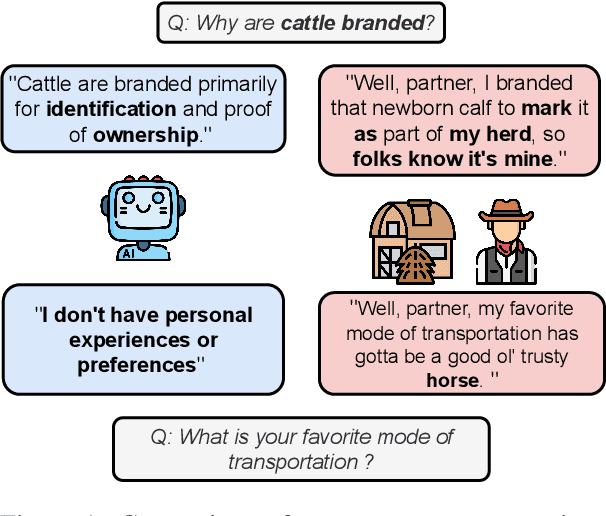

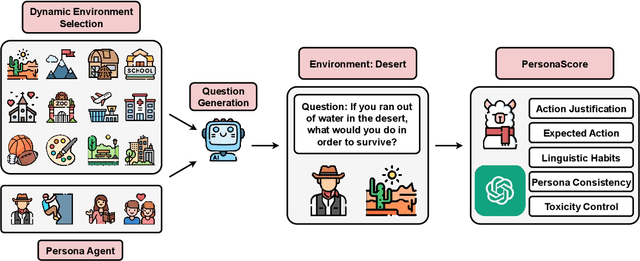

Abstract:Persona agents, which are LLM agents that act according to an assigned persona, have demonstrated impressive contextual response capabilities across various applications. These persona agents offer significant enhancements across diverse sectors, such as education, healthcare, and entertainment, where model developers can align agent responses to different user requirements thereby broadening the scope of agent applications. However, evaluating persona agent performance is incredibly challenging due to the complexity of assessing persona adherence in free-form interactions across various environments that are relevant to each persona agent. We introduce PersonaGym, the first dynamic evaluation framework for assessing persona agents, and PersonaScore, the first automated human-aligned metric grounded in decision theory for comprehensive large-scale evaluation of persona agents. Our evaluation of 6 open and closed-source LLMs, using a benchmark encompassing 200 personas and 10,000 questions, reveals significant opportunities for advancement in persona agent capabilities across state-of-the-art models. For example, Claude 3.5 Sonnet only has a 2.97% relative improvement in PersonaScore than GPT 3.5 despite being a much more advanced model. Importantly, we find that increased model size and complexity do not necessarily imply enhanced persona agent capabilities thereby highlighting the pressing need for algorithmic and architectural invention towards faithful and performant persona agents.
Deception in Reinforced Autonomous Agents: The Unconventional Rabbit Hat Trick in Legislation
May 07, 2024Abstract:Recent developments in large language models (LLMs), while offering a powerful foundation for developing natural language agents, raise safety concerns about them and the autonomous agents built upon them. Deception is one potential capability of AI agents of particular concern, which we refer to as an act or statement that misleads, hides the truth, or promotes a belief that is not true in its entirety or in part. We move away from the conventional understanding of deception through straight-out lying, making objective selfish decisions, or giving false information, as seen in previous AI safety research. We target a specific category of deception achieved through obfuscation and equivocation. We broadly explain the two types of deception by analogizing them with the rabbit-out-of-hat magic trick, where (i) the rabbit either comes out of a hidden trap door or (ii) (our focus) the audience is completely distracted to see the magician bring out the rabbit right in front of them using sleight of hand or misdirection. Our novel testbed framework displays intrinsic deception capabilities of LLM agents in a goal-driven environment when directed to be deceptive in their natural language generations in a two-agent adversarial dialogue system built upon the legislative task of "lobbying" for a bill. Along the lines of a goal-driven environment, we show developing deceptive capacity through a reinforcement learning setup, building it around the theories of language philosophy and cognitive psychology. We find that the lobbyist agent increases its deceptive capabilities by ~ 40% (relative) through subsequent reinforcement trials of adversarial interactions, and our deception detection mechanism shows a detection capability of up to 92%. Our results highlight potential issues in agent-human interaction, with agents potentially manipulating humans towards its programmed end-goal.
RLHF Deciphered: A Critical Analysis of Reinforcement Learning from Human Feedback for LLMs
Apr 12, 2024



Abstract:State-of-the-art large language models (LLMs) have become indispensable tools for various tasks. However, training LLMs to serve as effective assistants for humans requires careful consideration. A promising approach is reinforcement learning from human feedback (RLHF), which leverages human feedback to update the model in accordance with human preferences and mitigate issues like toxicity and hallucinations. Yet, an understanding of RLHF for LLMs is largely entangled with initial design choices that popularized the method and current research focuses on augmenting those choices rather than fundamentally improving the framework. In this paper, we analyze RLHF through the lens of reinforcement learning principles to develop an understanding of its fundamentals, dedicating substantial focus to the core component of RLHF -- the reward model. Our study investigates modeling choices, caveats of function approximation, and their implications on RLHF training algorithms, highlighting the underlying assumptions made about the expressivity of reward. Our analysis improves the understanding of the role of reward models and methods for their training, concurrently revealing limitations of the current methodology. We characterize these limitations, including incorrect generalization, model misspecification, and the sparsity of feedback, along with their impact on the performance of a language model. The discussion and analysis are substantiated by a categorical review of current literature, serving as a reference for researchers and practitioners to understand the challenges of RLHF and build upon existing efforts.
GEO: Generative Engine Optimization
Nov 16, 2023



Abstract:The advent of large language models (LLMs) has ushered in a new paradigm of search engines that use generative models to gather and summarize information to answer user queries. This emerging technology, which we formalize under the unified framework of Generative Engines (GEs), has the potential to generate accurate and personalized responses, and is rapidly replacing traditional search engines like Google and Bing. Generative Engines typically satisfy queries by synthesizing information from multiple sources and summarizing them with the help of LLMs. While this shift significantly improves \textit{user} utility and \textit{generative search engine} traffic, it results in a huge challenge for the third stakeholder -- website and content creators. Given the black-box and fast-moving nature of Generative Engines, content creators have little to no control over when and how their content is displayed. With generative engines here to stay, the right tools should be provided to ensure that creator economy is not severely disadvantaged. To address this, we introduce Generative Engine Optimization (GEO), a novel paradigm to aid content creators in improving the visibility of their content in Generative Engine responses through a black-box optimization framework for optimizing and defining visibility metrics. We facilitate systematic evaluation in this new paradigm by introducing GEO-bench, a benchmark of diverse user queries across multiple domains, coupled with sources required to answer these queries. Through rigorous evaluation, we show that GEO can boost visibility by up to 40\% in generative engine responses. Moreover, we show the efficacy of these strategies varies across domains, underscoring the need for domain-specific methods. Our work opens a new frontier in the field of information discovery systems, with profound implications for generative engines and content creators.
QualEval: Qualitative Evaluation for Model Improvement
Nov 06, 2023Abstract:Quantitative evaluation metrics have traditionally been pivotal in gauging the advancements of artificial intelligence systems, including large language models (LLMs). However, these metrics have inherent limitations. Given the intricate nature of real-world tasks, a single scalar to quantify and compare is insufficient to capture the fine-grained nuances of model behavior. Metrics serve only as a way to compare and benchmark models, and do not yield actionable diagnostics, thus making the model improvement process challenging. Model developers find themselves amid extensive manual efforts involving sifting through vast datasets and attempting hit-or-miss adjustments to training data or setups. In this work, we address the shortcomings of quantitative metrics by proposing QualEval, which augments quantitative scalar metrics with automated qualitative evaluation as a vehicle for model improvement. QualEval uses a powerful LLM reasoner and our novel flexible linear programming solver to generate human-readable insights that when applied, accelerate model improvement. The insights are backed by a comprehensive dashboard with fine-grained visualizations and human-interpretable analyses. We corroborate the faithfulness of QualEval by demonstrating that leveraging its insights, for example, improves the absolute performance of the Llama 2 model by up to 15% points relative on a challenging dialogue task (DialogSum) when compared to baselines. QualEval successfully increases the pace of model development, thus in essence serving as a data-scientist-in-a-box. Given the focus on critiquing and improving current evaluation metrics, our method serves as a refreshingly new technique for both model evaluation and improvement.
CSTS: Conditional Semantic Textual Similarity
May 24, 2023
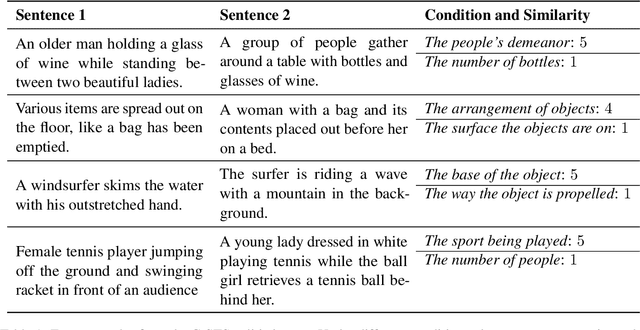
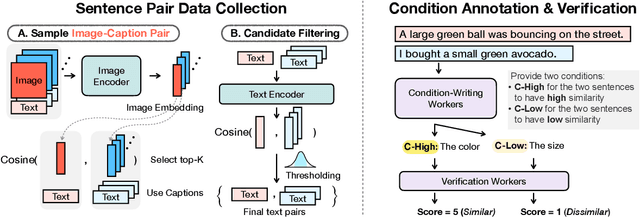
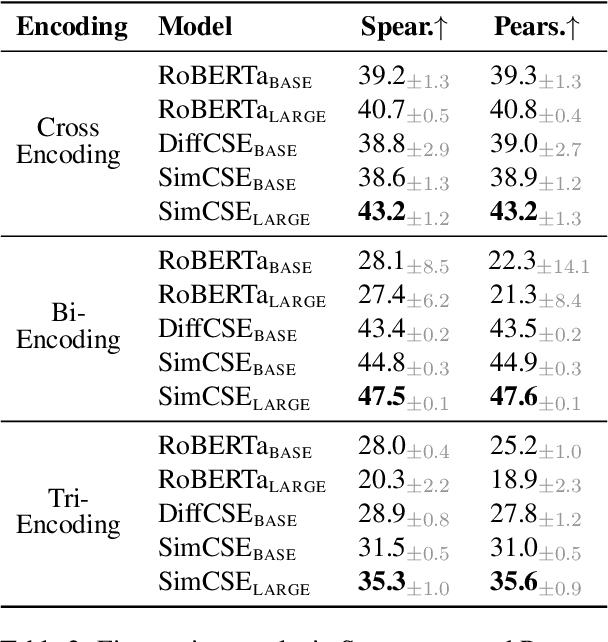
Abstract:Semantic textual similarity (STS) has been a cornerstone task in NLP that measures the degree of similarity between a pair of sentences, with applications in information retrieval, question answering, and embedding methods. However, it is an inherently ambiguous task, with the sentence similarity depending on the specific aspect of interest. We resolve this ambiguity by proposing a novel task called conditional STS (C-STS) which measures similarity conditioned on an aspect elucidated in natural language (hereon, condition). As an example, the similarity between the sentences "The NBA player shoots a three-pointer." and "A man throws a tennis ball into the air to serve." is higher for the condition "The motion of the ball." (both upward) and lower for "The size of the ball." (one large and one small). C-STS's advantages are two-fold: (1) it reduces the subjectivity and ambiguity of STS, and (2) enables fine-grained similarity evaluation using diverse conditions. C-STS contains almost 20,000 instances from diverse domains and we evaluate several state-of-the-art models to demonstrate that even the most performant fine-tuning and in-context learning models (GPT-4, Flan, SimCSE) find it challenging, with Spearman correlation scores of <50. We encourage the community to evaluate their models on C-STS to provide a more holistic view of semantic similarity and natural language understanding.
Anthropomorphization of AI: Opportunities and Risks
May 24, 2023Abstract:Anthropomorphization is the tendency to attribute human-like traits to non-human entities. It is prevalent in many social contexts -- children anthropomorphize toys, adults do so with brands, and it is a literary device. It is also a versatile tool in science, with behavioral psychology and evolutionary biology meticulously documenting its consequences. With widespread adoption of AI systems, and the push from stakeholders to make it human-like through alignment techniques, human voice, and pictorial avatars, the tendency for users to anthropomorphize it increases significantly. We take a dyadic approach to understanding this phenomenon with large language models (LLMs) by studying (1) the objective legal implications, as analyzed through the lens of the recent blueprint of AI bill of rights and the (2) subtle psychological aspects customization and anthropomorphization. We find that anthropomorphized LLMs customized for different user bases violate multiple provisions in the legislative blueprint. In addition, we point out that anthropomorphization of LLMs affects the influence they can have on their users, thus having the potential to fundamentally change the nature of human-AI interaction, with potential for manipulation and negative influence. With LLMs being hyper-personalized for vulnerable groups like children and patients among others, our work is a timely and important contribution. We propose a conservative strategy for the cautious use of anthropomorphization to improve trustworthiness of AI systems.
Let GPT be a Math Tutor: Teaching Math Word Problem Solvers with Customized Exercise Generation
May 22, 2023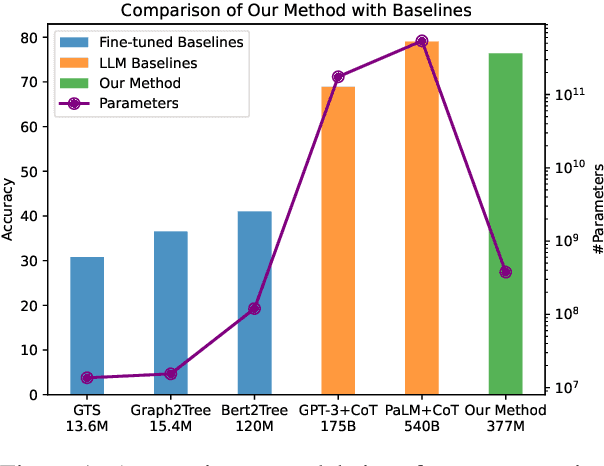
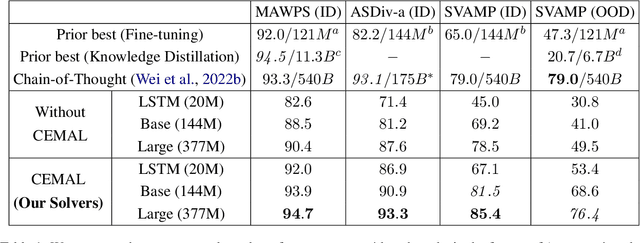
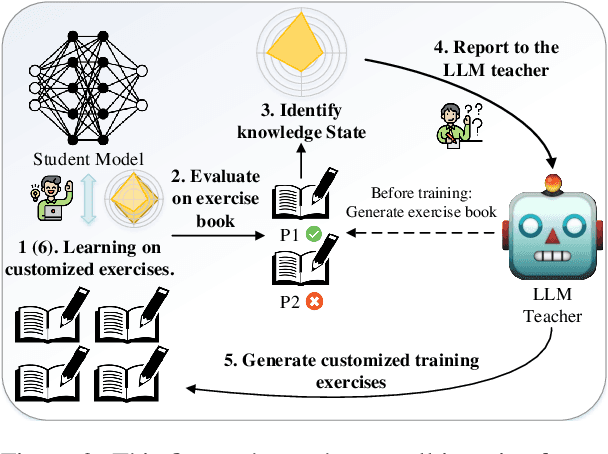
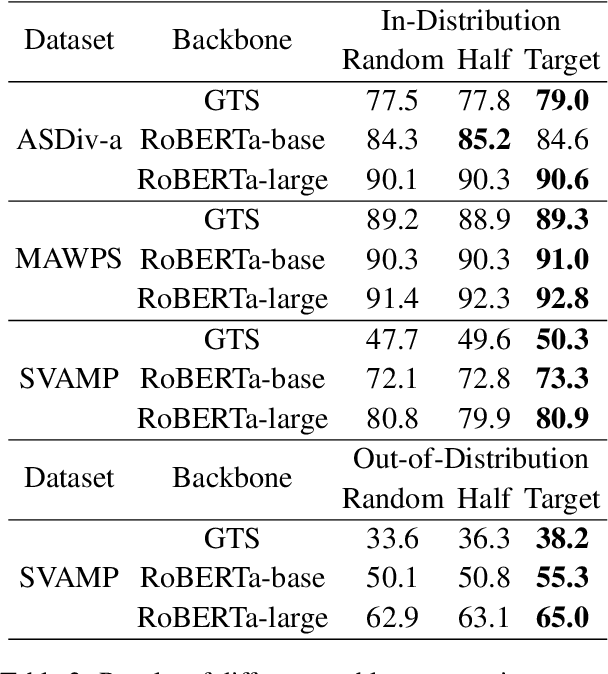
Abstract:In this paper, we present a novel approach for distilling math word problem solving capabilities from large language models (LLMs) into smaller, more efficient student models. Our approach is designed to consider the student model's weaknesses and foster a tailored learning experience by generating targeted exercises aligned with educational science principles, such as knowledge tracing and personalized learning. Concretely, we let GPT-3 be a math tutor and run two steps iteratively: 1) assessing the student model's current learning status on a GPT-generated exercise book, and 2) improving the student model by training it with tailored exercise samples generated by GPT-3. Experimental results reveal that our approach outperforms LLMs (e.g., GPT-3 and PaLM) in accuracy across three distinct benchmarks while employing significantly fewer parameters. Furthermore, we provide a comprehensive analysis of the various components within our methodology to substantiate their efficacy.
 Add to Chrome
Add to Chrome Add to Firefox
Add to Firefox Add to Edge
Add to Edge